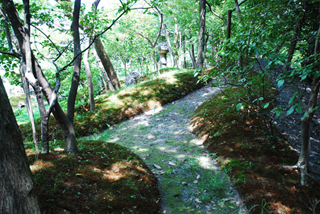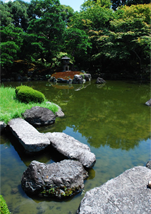There is nothing ostentatious here. Rare types of timber are used in abundance, yet always with restrained good taste: Yakushima cedar for the ceiling, Kitayama cedar for the tokobashira (alcove post), and solid beams with tamamoku* patterns for the tokonoma (alcove). Bamboo is used for the frames of ranma (transoms).
*Exquisite wood grain with swirls and ripples
The living room is a cozy six-tatami space. Polished logs, timber finished with the naguri method, and lumber with the bark still on it are used to conjure up a rustic ambience of inviting informality. As if taking its cue from this atmosphere, the tsuchibisashi (pent roof) projects above a hardpacked earthen floor. The indoor-like outside area created by the tsuchibisashi achieves continuity between the living quarters and the garden, with the eaves lowering the vantage point, subtly leading the eye toward the stone lantern and the chouzubachi water basin in the near distance. Sutebashira (pillars) supporting the eave purlin are simple in design, their knots trimmed with a hatchet. The base stones anchoring the sutebashira are of varied shape and texture, like the stones used in gardens, revealing the aesthetic dividend of intimate collaboration between the carpenter and the gardener.
Kinmochi’s living quarters were in the annex, a two-story building. The first floor is notable for its saruboo saobuchi ceiling whose battens are arranged in such a fashion as to suggest the face of a monkey. The ranma (transoms) feature a comb-shaped pattern, a signature motif of Jinbee Yagi, Jr. Together with the marumado circular window of the tokonoma alcove, all these elements combine to create an elegant space. The south-facing engawa veranda is in the keshou nokiura style, leaving the underside of the eaves exposed. The continuity with the garden is readily apparent here, too. The orderly arrangement of polished cedar nokigeta (pole plates) and taruki (rafters) complete the aesthetically pleasing effect.

 EN
EN







